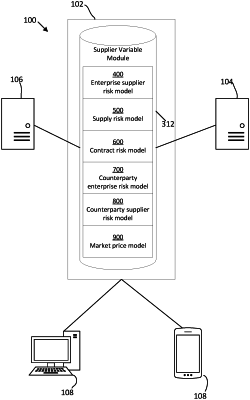| CPC G06Q 10/0635 (2013.01) [G06F 18/214 (2023.01); G06N 20/00 (2019.01); G06Q 10/0835 (2013.01)] | 23 Claims |

|
1. A computer-implemented method, the method being performed by a marketplace application server having a processor and comprising:
executing a marketplace application which connects one or more enterprises with one or more approved suppliers, based on a supplier data state for each of the one or more approved suppliers;
receiving, by the marketplace application, sets of data, the sets of data comprising i) user historical data in relation to one or more parties to one or more respective contracts executed through the marketplace application, the one or more parties including at least one of the one or more approved suppliers, and the user historical data including qualitative supplier risk assessment information, ii) a global historical data set, and iii) an external data set, wherein an accessible local database or a remote database includes the sets of data and a list of the one or more approved suppliers for each enterprise that is a user of the marketplace application;
training, by the processor using a training data set, a first set of risk models in a neural network including multiple layers of neurons, each neuron having a weight value and receiving inputs from a previous layer of the neural network, the training data set including portions of information contained in the user historical data set, the global historical data set, and the external data set, the training of the first set of risk models including adjusting one or more weights of the first set of risk models;
receiving or deriving, by a supplier variable module of the marketplace application, including the first set of risk models: contract attributes of a supplier contract or a potential supplier contract;
generating, by the supplier variable module based on the sets of data and the contract attributes: a set of outcomes for the supplier contract or the potential supplier contract, the set of outcomes including: a counterparty risk estimate, a contract risk estimate, a supply risk estimate, and a market price estimate;
generating, by a counterparty supplier risk model of the supplier variable module: a counterparty supplier risk estimate;
generating, by a counterparty enterprise risk model of the supplier variable module: a counterparty enterprise risk estimate;
wherein the supplier variable module includes a contract risk model configured to generate the contract risk estimate,
wherein the supplier variable module includes a supply risk model configured to generate the supply risk estimate,
wherein the supplier variable module includes a market price model configured to generate the market price estimate,
wherein the counterparty risk estimate includes the counterparty enterprise risk estimate and the counterparty supplier risk estimate,
wherein the counterparty enterprise risk model and the counterparty supplier risk model receive, as input, the qualitative supplier risk assessment information, and
wherein the counterparty enterprise risk estimate is generated by aggregating one or more itemized inputs and relative risk weightings of the qualitative supplier risk assessment information,
wherein the counterparty supplier risk estimate is generated according to the following equation:
Counterparty Supplier Risk(t)=Current Exposure(t)+Potential Future Exposure(t)+Settlement Risk(t)−Collateral(t);
wherein Collateral(t) is a collateral;
detecting a change in the supplier data state for the at least one of the one or more approved suppliers, the change being a change in the set of outcomes relative to a threshold value, the threshold value being learned by the neural network of the supplier variable module;
in response to detecting the change in the supplier data state:
generating, by the marketplace application, at least one recommendation based on the change in the supplier data state, the at least one recommendation directed to a risk mitigation action that when executed, causes a reduction or mitigation in risk associated with the supplier contract or the potential supplier contract; and
updating a user-interface of the marketplace application to reflect the change in the supplier data state and the at least one recommendation; and
training the first set of risk models in the neural network using data associated with updated user historical data, updated global historical data, updated external data and the set of outcomes, to generate a second set of risk models by adjusting one or more second weights of the first set of risk models.
|